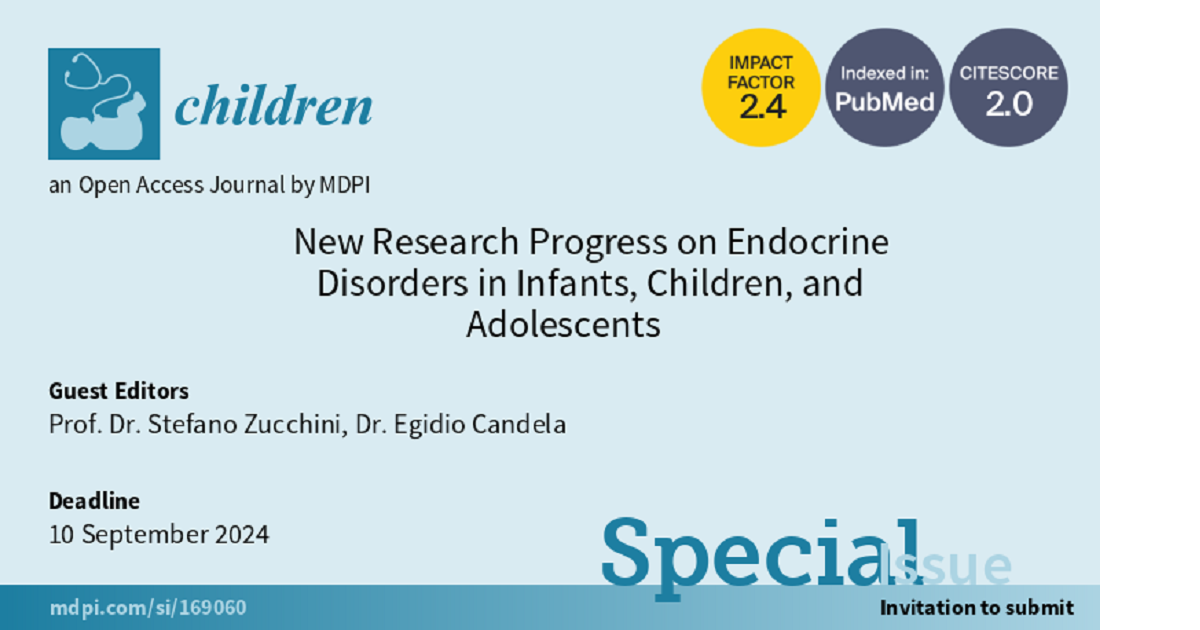New Research Progress on Endocrine Disorders in Infants, Children, and Adolescents
A special issue of Children (ISSN 2227-9067). This special issue belongs to the section "Pediatric Endocrinology & Diabetes".
Deadline for manuscript submissions: closed (10 September 2024) | Viewed by 13653

Special Issue Editors
Interests: diabetes mellitus; clinical endocrinology; pediatric endocrinology; diabetes
Special Issue Information
Dear Colleagues,
It is with great pleasure that we invite you on behalf of Children to submit your research, reviews, clinical practice guidelines, case reports, and other article types in this Special Issue entitled “New Research Progress on Endocrine Disorders in Infants, Children, and Adolescents”.
In the current Special Issue, we will focus on advancements made in the field of pediatric endocrinology, an exciting and constantly evolving field of study. In fact, we are confident that only through a constant collaboration among experts in this clinic area can progress be made in sectors such as disorders involving growth, pubertal development, sexual differentiation and development, thyroid and adrenal, pituitary tumors, calcium, phosphorus, vitamin D and bone metabolism, obesity, metabolic syndrome and others.
Our aim is to disseminate new basic and clinical knowledge useful for both specialists and pediatricians and we would especially like to give space to new original cases and modern approaches in patient diagnostic, management or innovative therapies
Prof. Dr. Stefano Zucchini
Guest Editor
Dr. Egidio Candela
Guest Editor Assistant
Manuscript Submission Information
Manuscripts should be submitted online at www.mdpi.com by registering and logging in to this website. Once you are registered, click here to go to the submission form. Manuscripts can be submitted until the deadline. All submissions that pass pre-check are peer-reviewed. Accepted papers will be published continuously in the journal (as soon as accepted) and will be listed together on the special issue website. Research articles, review articles as well as short communications are invited. For planned papers, a title and short abstract (about 100 words) can be sent to the Editorial Office for announcement on this website.
Submitted manuscripts should not have been published previously, nor be under consideration for publication elsewhere (except conference proceedings papers). All manuscripts are thoroughly refereed through a single-blind peer-review process. A guide for authors and other relevant information for submission of manuscripts is available on the Instructions for Authors page. Children is an international peer-reviewed open access monthly journal published by MDPI.
Please visit the Instructions for Authors page before submitting a manuscript. The Article Processing Charge (APC) for publication in this open access journal is 2400 CHF (Swiss Francs). Submitted papers should be well formatted and use good English. Authors may use MDPI's English editing service prior to publication or during author revisions.
Keywords
- pediatric endocrinology
- pediatric endocrine tumors
- gland disorders (adrenal, pituitary, thyroid)
- pediatric obesity
- disorders of growth and growth factors
- sexual dysfunctions
- bone and mineral metabolism
- pediatric thyroid disorders
Benefits of Publishing in a Special Issue
- Ease of navigation: Grouping papers by topic helps scholars navigate broad scope journals more efficiently.
- Greater discoverability: Special Issues support the reach and impact of scientific research. Articles in Special Issues are more discoverable and cited more frequently.
- Expansion of research network: Special Issues facilitate connections among authors, fostering scientific collaborations.
- External promotion: Articles in Special Issues are often promoted through the journal's social media, increasing their visibility.
- Reprint: MDPI Books provides the opportunity to republish successful Special Issues in book format, both online and in print.
Further information on MDPI's Special Issue policies can be found here.







